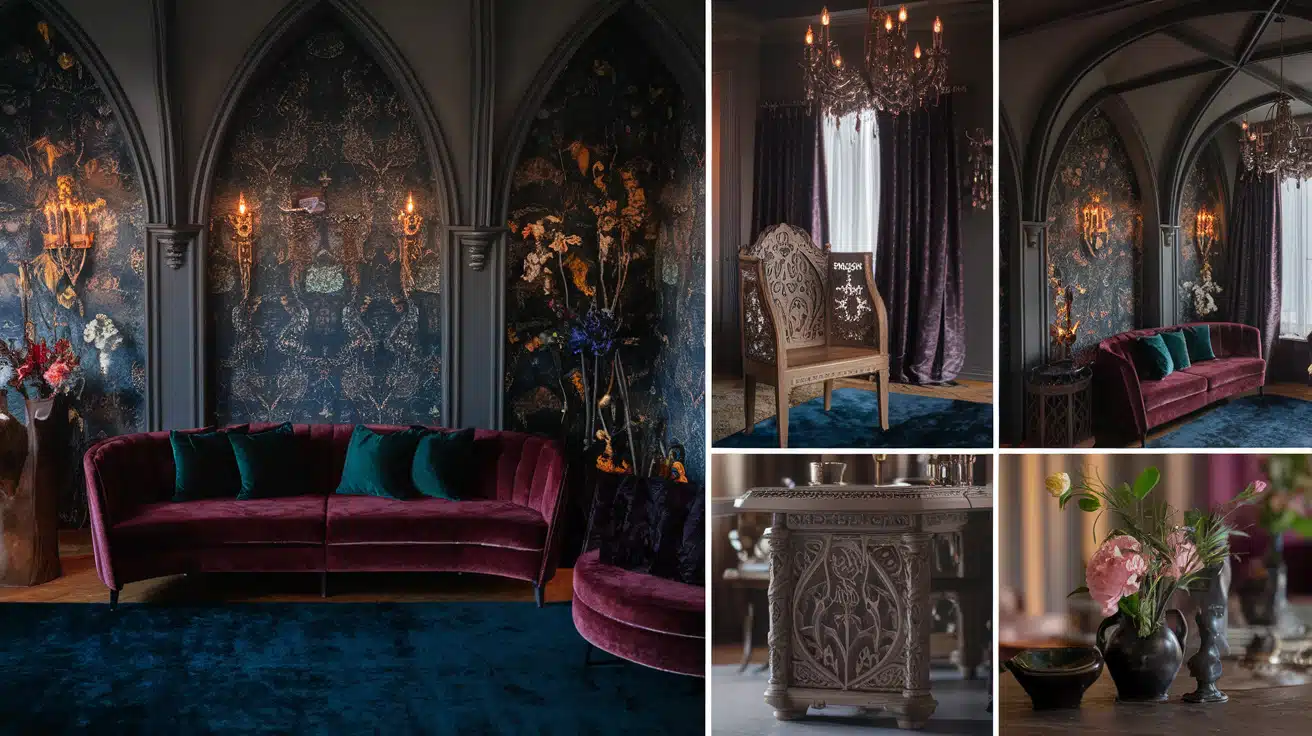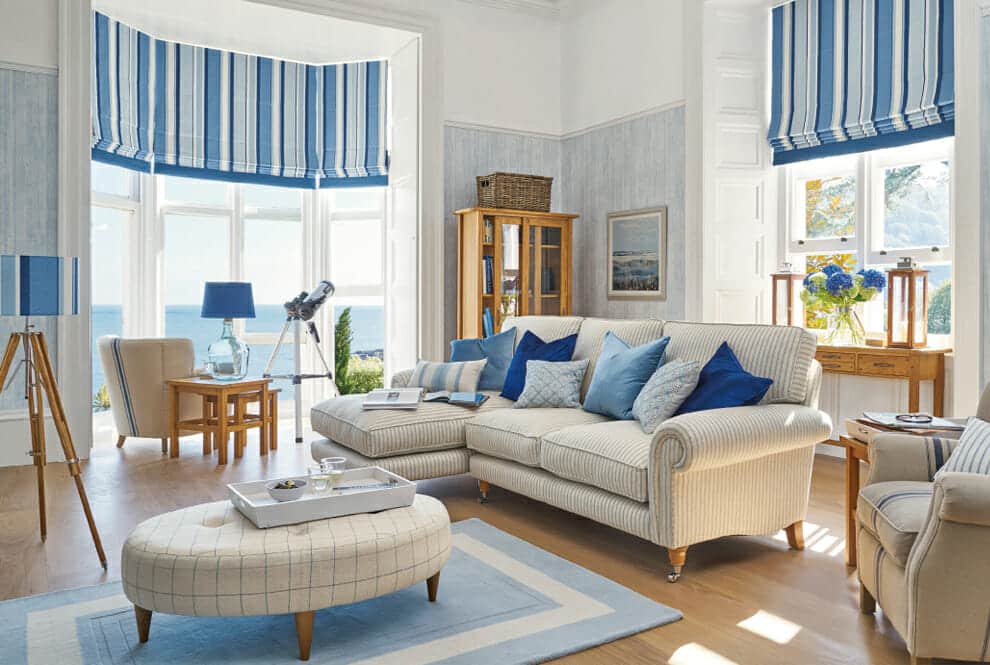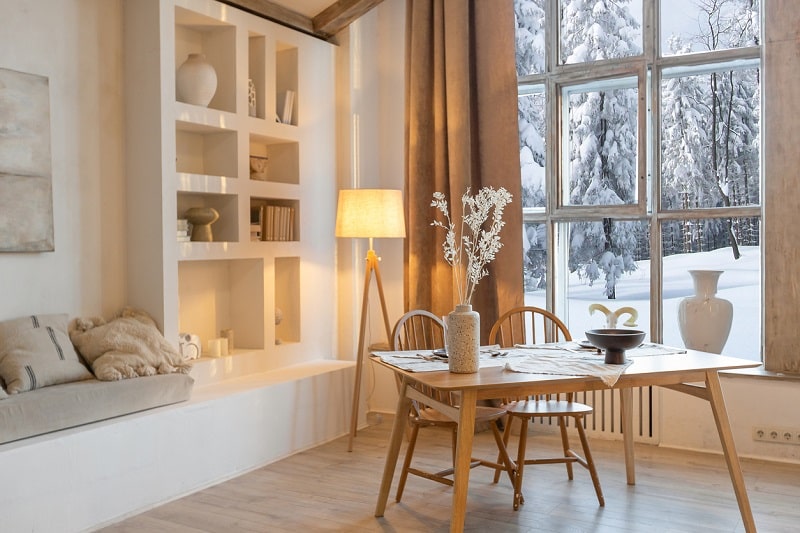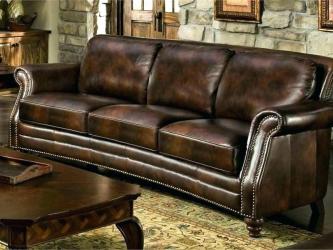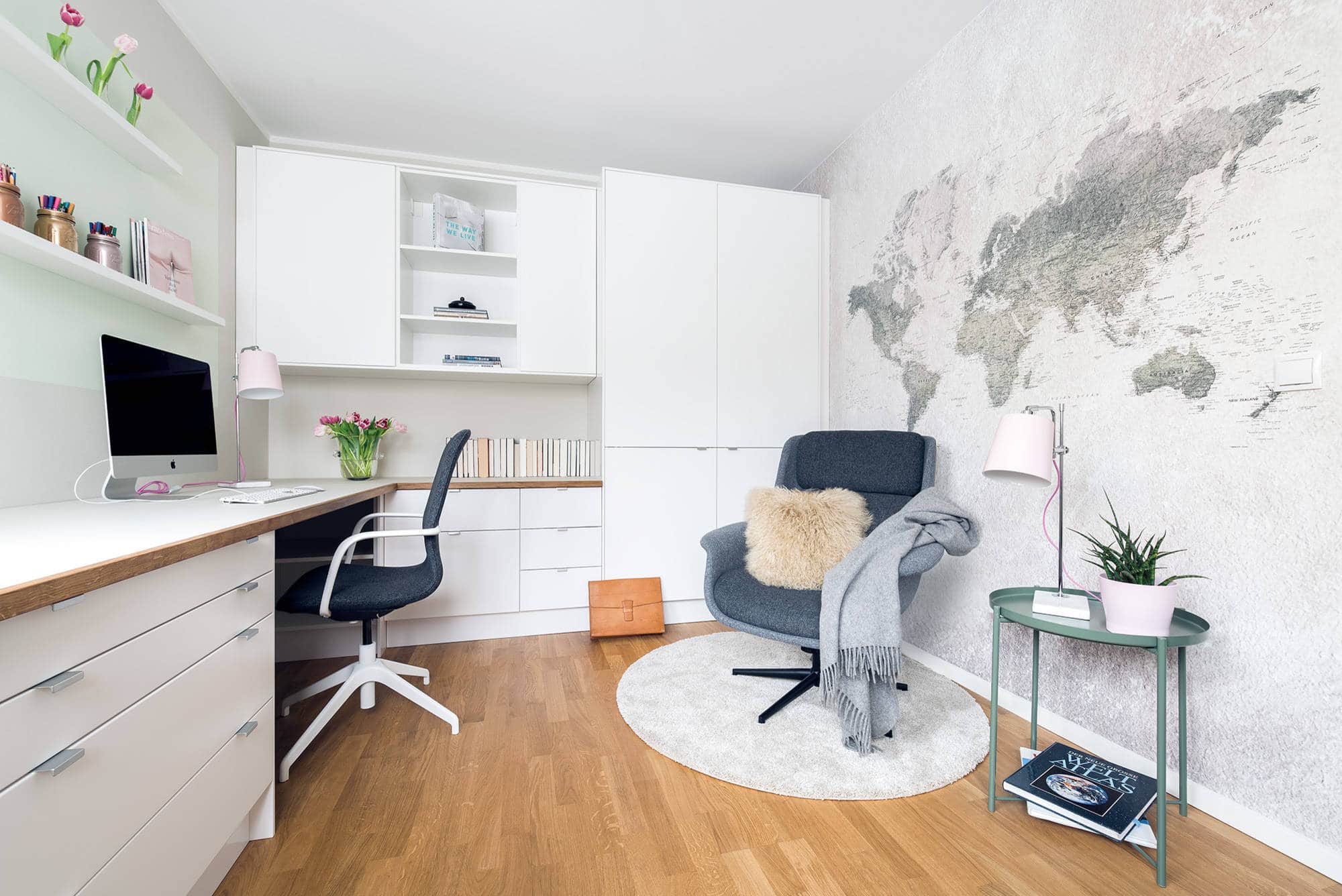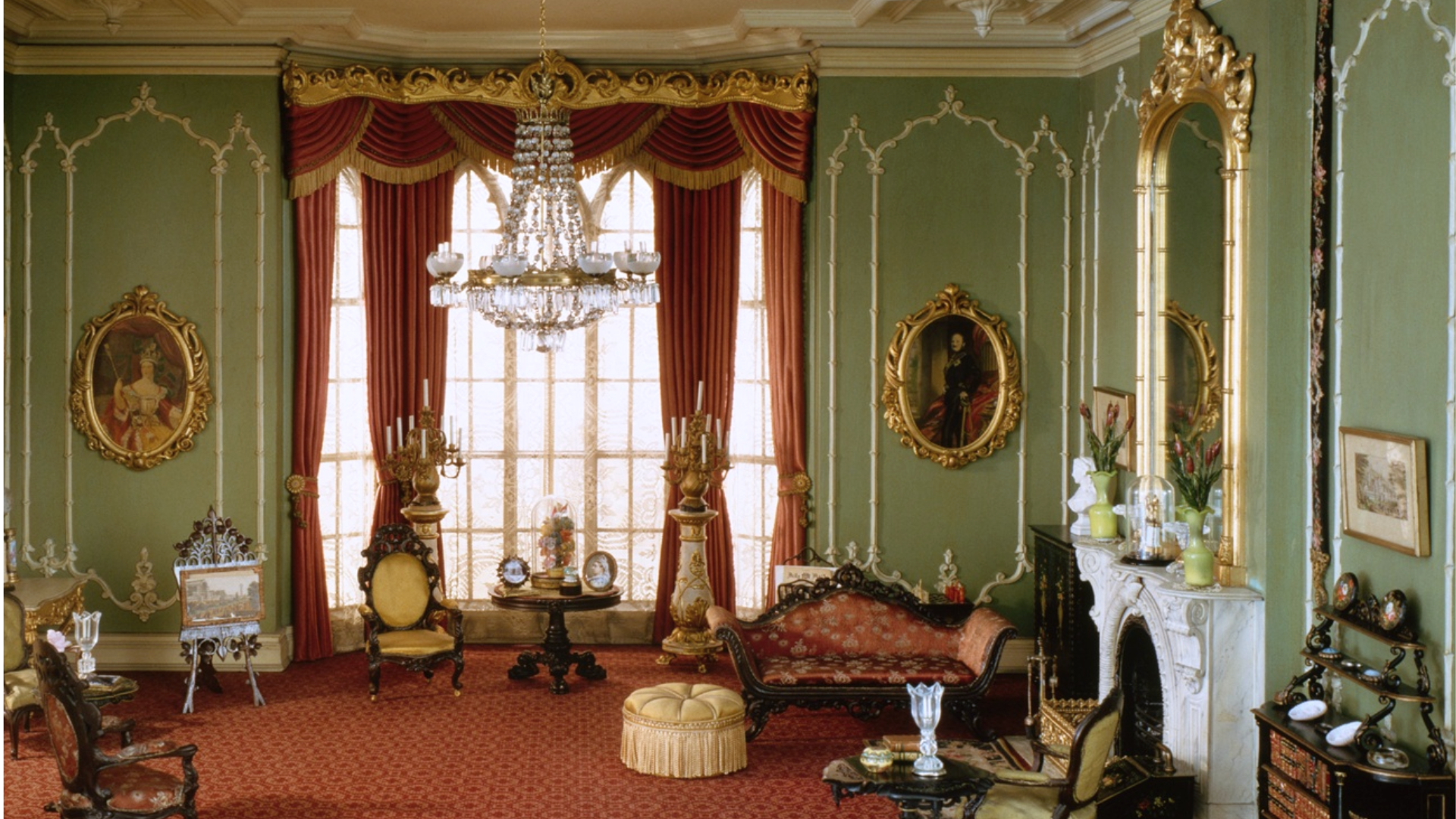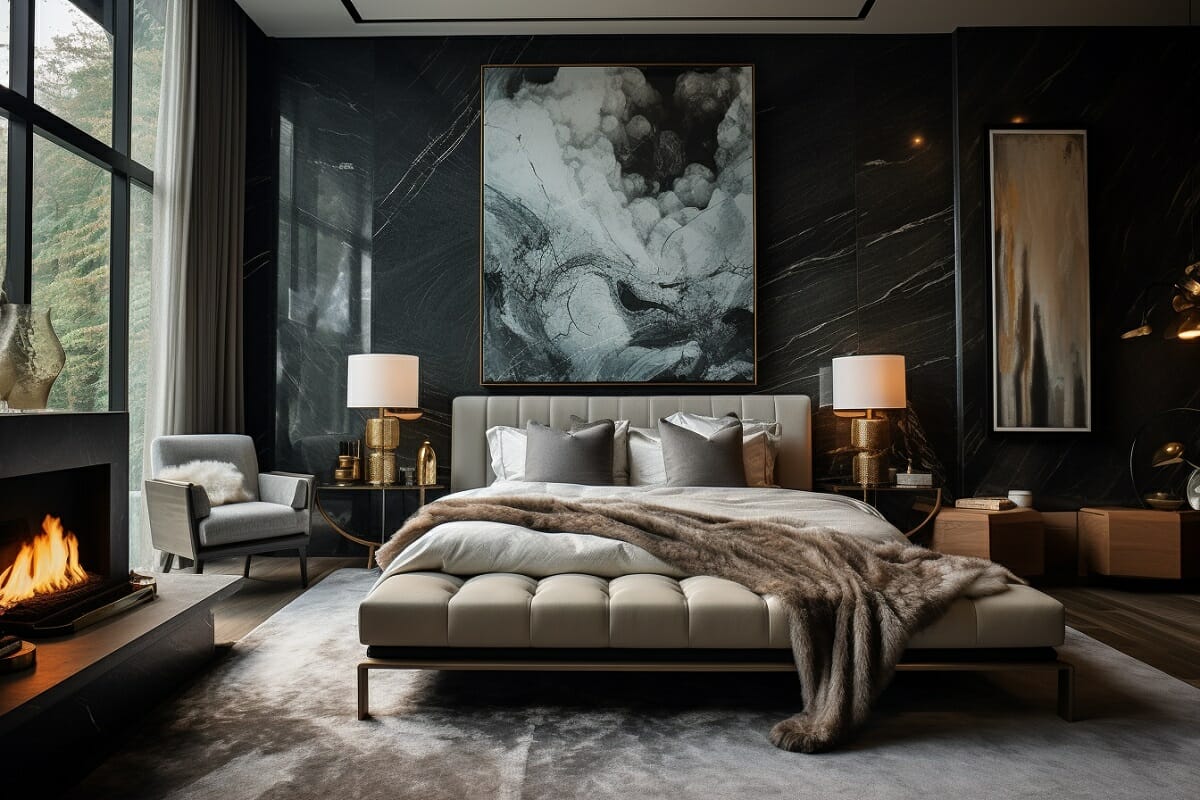Gothic Architecture Interior Design 101
Are you interested in knowing about Gothic design? Then you are in the right place.
Welcome to our guide on Gothic interior design.
This blog explains how to bring a dramatic, medieval-inspired style into modern homes through rich colors, distinctive designer features, and luxurious textures.
We’ll walk through room-by-room applications from moody living rooms to dramatic dining spaces—and show how to balance historical elements with contemporary needs.
Whether you are working with authentic Gothic architecture or adding Gothic touches to a standard home, you’ll find practical advice.
Create spaces that honor this style while remaining comfortable and functional for today’s living.
What is Gothic Architecture Interior?
Gothic architecture interior style brings medieval-inspired design into modern homes. It features pointed arches, intricate woodwork, and dramatic contrasts that create atmospheric spaces.
Key elements include deep colors like burgundy, forest green, and navy blue, often balanced with metallic accents in gold or silver.
Luxurious textures play an important role, with velvet upholstery, heavy draperies, and detailed carvings adding richness.
Statement lighting through chandeliers and wall sconces creates the characteristic moody ambiance.
The best Gothic interiors balance historical drama with modern comfort, thoughtfully incorporating traditional elements rather than creating museum-like spaces.
Key Characteristics of Gothic Architecture Interior
Moody Color Palette
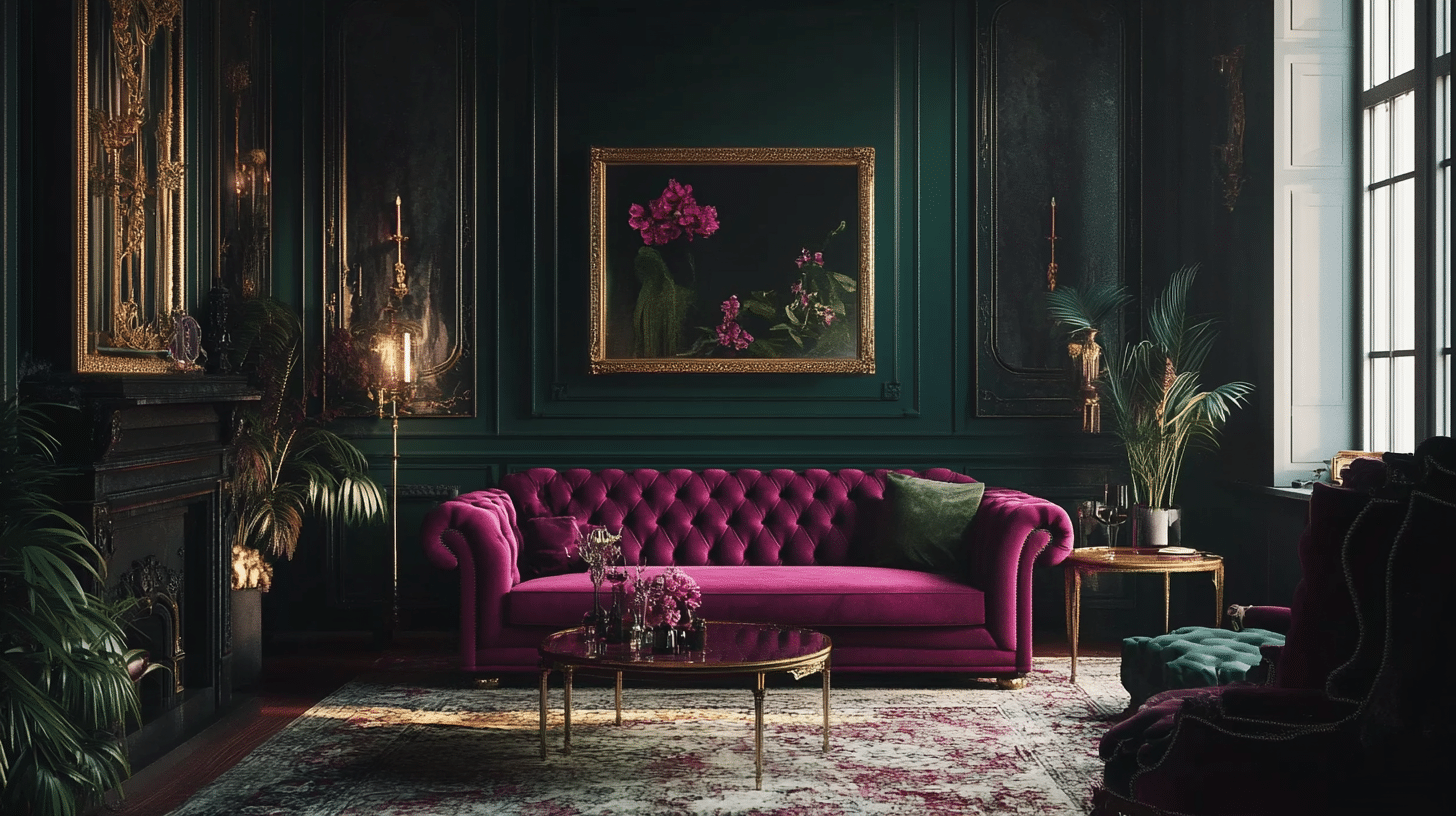
Gothic design embraces deep, rich colors like burgundy, forest green, midnight blue, and plum as its foundation. These dark hues create a dramatic backdrop for everyday living.
Accent colors, including gold, silver, and jewel tones (emerald, ruby, sapphire), add necessary brightness and luxury.
The contrast between dark backgrounds and bright accents creates visual interest and draws attention to special pieces.
This color strategy builds rooms that feel both historic and welcoming.
Gothic Motifs

Medieval elements define Gothic interiors through distinctive architectural features.
Pointed arches appear in doorways, windows, and furniture details, immediately establishing the Gothic character.
Intricate woodwork on ceiling beams, wall panels, and cabinets showcases historical craftsmanship.
Grotesque features like gargoyles and mythical creatures (dragons, griffins, lions) serve as unique decorative objects and conversation pieces.
These traditional elements bring an authentic medieval personality to modern homes while connecting to design history.
Luxurious Textures
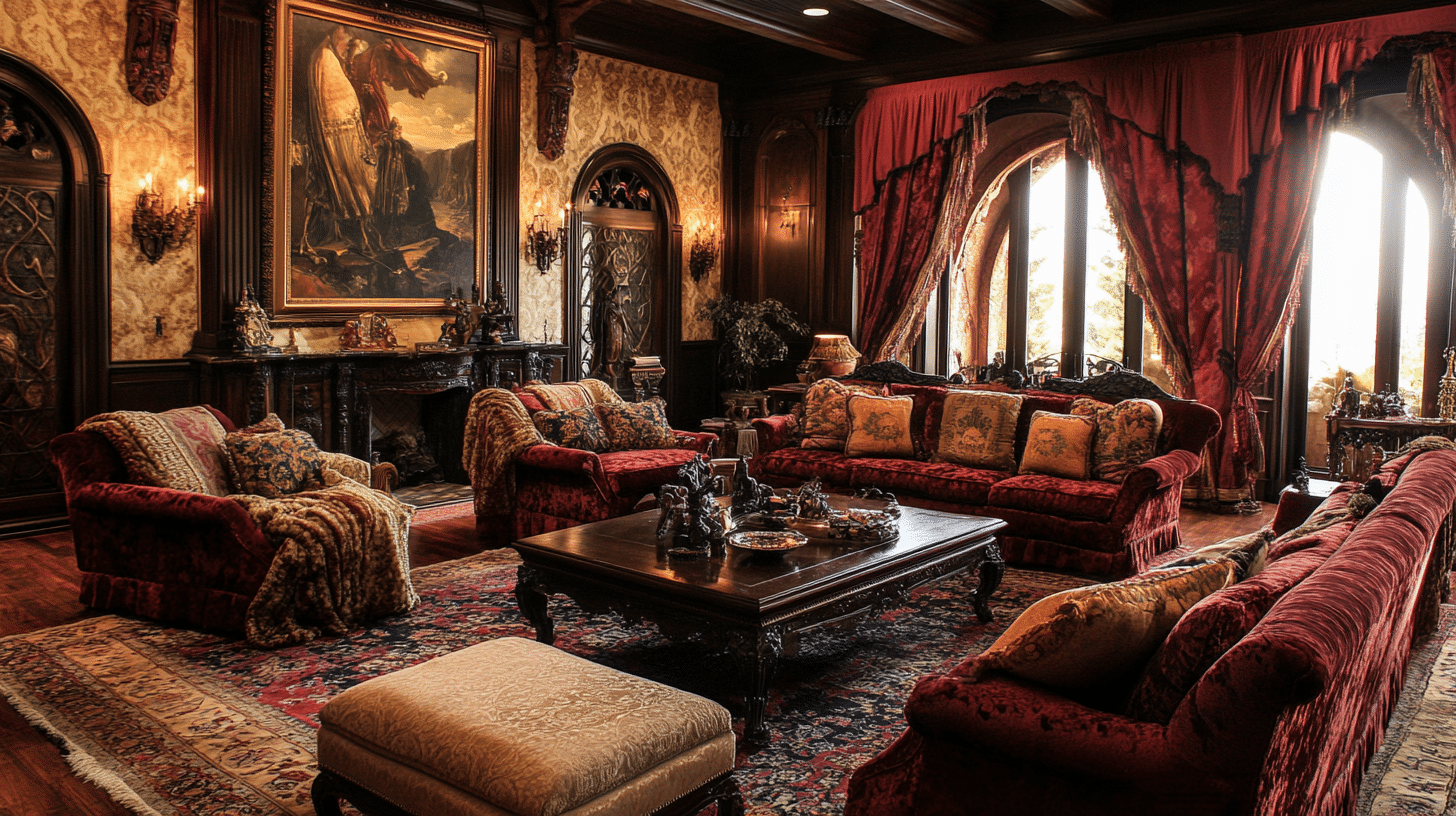
Gothic spaces rely on rich, tactile materials that engage the senses. Velvet upholstery on furniture creates depth and captures light differently as you move through a room.
Jacquard fabrics add visual complexity to curtains and smaller pieces. Wall hangings improve acoustics while displaying historical or nature scenes.
Thick rugs define spaces and add warmth to stone or wood floors. Heavy drapery frames windows dramatically while improving insulation.
These layered textiles create rooms that feel both historically accurate and thoroughly comfortable.
Incorporation of Gothic Design Elements into Your Home
Architectural Grandeur
You can add Gothic architectural touches to any home, even without major renovations.
For doorways, consider adding arched molding above existing entrances to create the pointed arch effect that’s central to Gothic design.
This simple addition transforms basic rectangular openings into more dramatic focal points. High ceilings can be emphasized with dark paint or added beams to draw the eye upward—a core Gothic principle.
In homes with standard ceiling heights, tall curtains hung close to the ceiling create visual height.
Ornate woodwork doesn’t require custom carpentry—look for Gothic-inspired trim at specialty home stores, or add wooden appliqués to plain doors, cabinets, and fireplace mantels.
Even simple wooden panels applied in geometric patterns to walls can suggest Gothic wall treatments without extensive remodeling.
Gothic Color Palette
The right colors immediately establish a Gothic atmosphere. Deep emerald green brings natural richness to dining rooms and studies.
Sapphire blue creates tranquil drama in bedrooms and formal living spaces. Ruby red adds warmth to energy-starved rooms, while amethyst purple brings unexpected luxury to powder rooms or accent walls.
Balance these intense colors with soft neutral backgrounds—warm grays, creams, and taupes provide breathing space and highlight architectural details.
Metallic accents in brass, bronze, or copper add necessary light reflection, which is especially important in Gothic interiors, where general lighting is often kept low.
For lighting, focus on layers—combine dim overhead sources with strategic accent lights that highlight architectural features and art.
Wall sconces at eye level create the intimate atmosphere essential to Gothic rooms, while candles (real or flameless) add authentic, flattering light for evening gatherings.
Adding Gothic Motifs
Gothic-inspired furniture makes an immediate impact—look for pieces with pointed arch details, quatrefoil cutouts, or spiral turnings.
A carved wooden headboard, a throne-like chair, or a detailed buffet can anchor a room. Ornate cornices above windows add architectural interest and historical accuracy.
For the truly adventurous, small gargoyle figures bring authentic Gothic character to gardens, bookshelves, or fireplace mantels.
These mythical creatures were designed to ward off evil spirits and add distinctive personalities to modern spaces.
The key to using Gothic motifs successfully is restraint—choose one or two significant pieces rather than filling a room with competing ornate elements.
This selective approach maintains a modern sensibility while honoring Gothic traditions. In contemporary homes, pair these detailed items with simpler modern pieces for balance and livability.
This thoughtful mixing of periods creates spaces with depth and personality, avoiding theme-room territory while capturing the enduring appeal.
How to Create a Moody Gothic Living Room
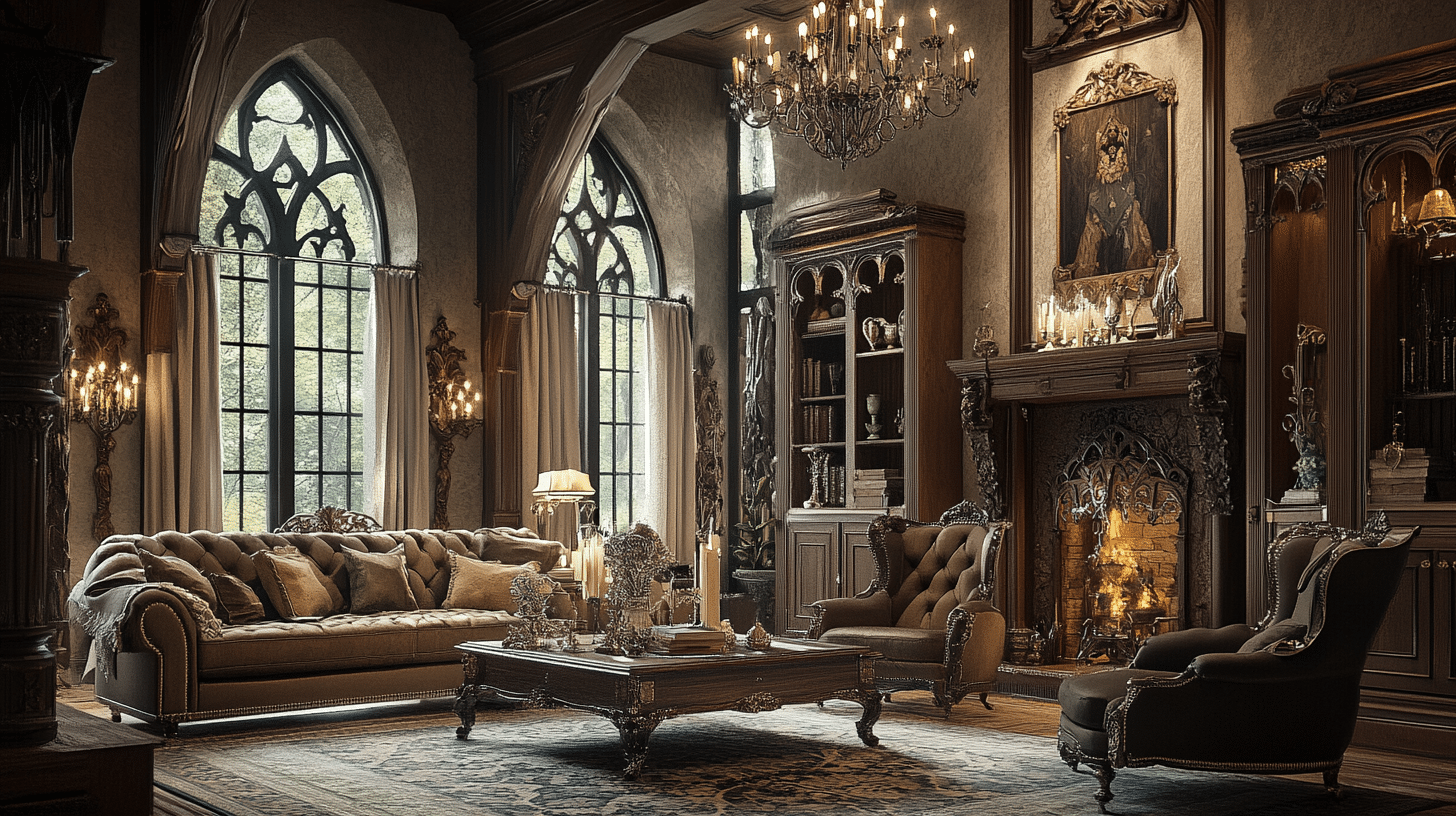
Room Layouts
Create a Gothic living room by arranging furniture asymmetrically for a naturally evolved feel.
Position a large sofa with two different chairs that share similar heights to maintain balance without perfect symmetry.
Make a fireplace the central focus, enhanced with dark stone or carved wood. If you don’t have a fireplace, use dramatic artwork or an ornate mirror as your focal point.
Lighting is crucial—install an iron or bronze chandelier as your main source, keeping bulbs at lower wattage for a softer glow. Add wall sconces to highlight architectural details and provide reading light.
Include table lamps with colored glass shades for additional warm light.
Incorporate varied wood tones through furniture, flooring, and architectural elements like ceiling beams or wall panels to bring warmth to the space and balance darker colors.
Feature Elements
Gothic motifs give your living room its distinctive character.
Look for furniture with carved details, such as pointed arches, quatrefoils, or nature-inspired patterns. Include one standout piece with substantial carving—a throne-style chair, detailed cabinet, or ornate bookcase.
Choose large, substantial furniture, such as deep sofas with tufted backs and hefty coffee tables that can display decorative objects. Balance historical elements with contemporary touches for livability.
Hide modern technology in carved cabinets, update traditional pieces with current fabrics in historical colors, and mix in some cleaner-lined modern items for contrast.
This blend creates a Gothic space that feels authentic yet comfortable for daily use—atmospheric and dramatic but still practical and welcoming, with genuine character rather than a museum-like stiffness.
Creating a Gothic Bedroom

Peaceful and Dramatic Ambiance
Through thoughtful color choices, a Gothic bedroom can balance drama with tranquility.
Paint walls in deep navy blue, forest green, or charcoal gray to create a moody backdrop that feels both historic and restful.
These colors work well with natural and artificial light and change subtly throughout the day.
Quality materials are essential for bedding and window treatments.
Choose pure linen sheets for their natural texture and breathability or velvet duvets and pillows that catch light beautifully.
Layer different fabrics—perhaps wool throws over silk pillows—to add depth and interest to the bed.
Room Features
Arrange furniture symmetrically to create a sense of order and calm. Center your bed on the main wall with identical nightstands and lamps on either side.
Choose a substantial bed frame with a tall headboard, ideally with carved details or tufted upholstery in a rich fabric.
Add a small reading corner with a comfortable chair and a side table near a window.
This creates a functional retreat within the bedroom. A bench at the foot of the bed offers a place to sit while providing extra storage.
Gothic Dining Room Ideas
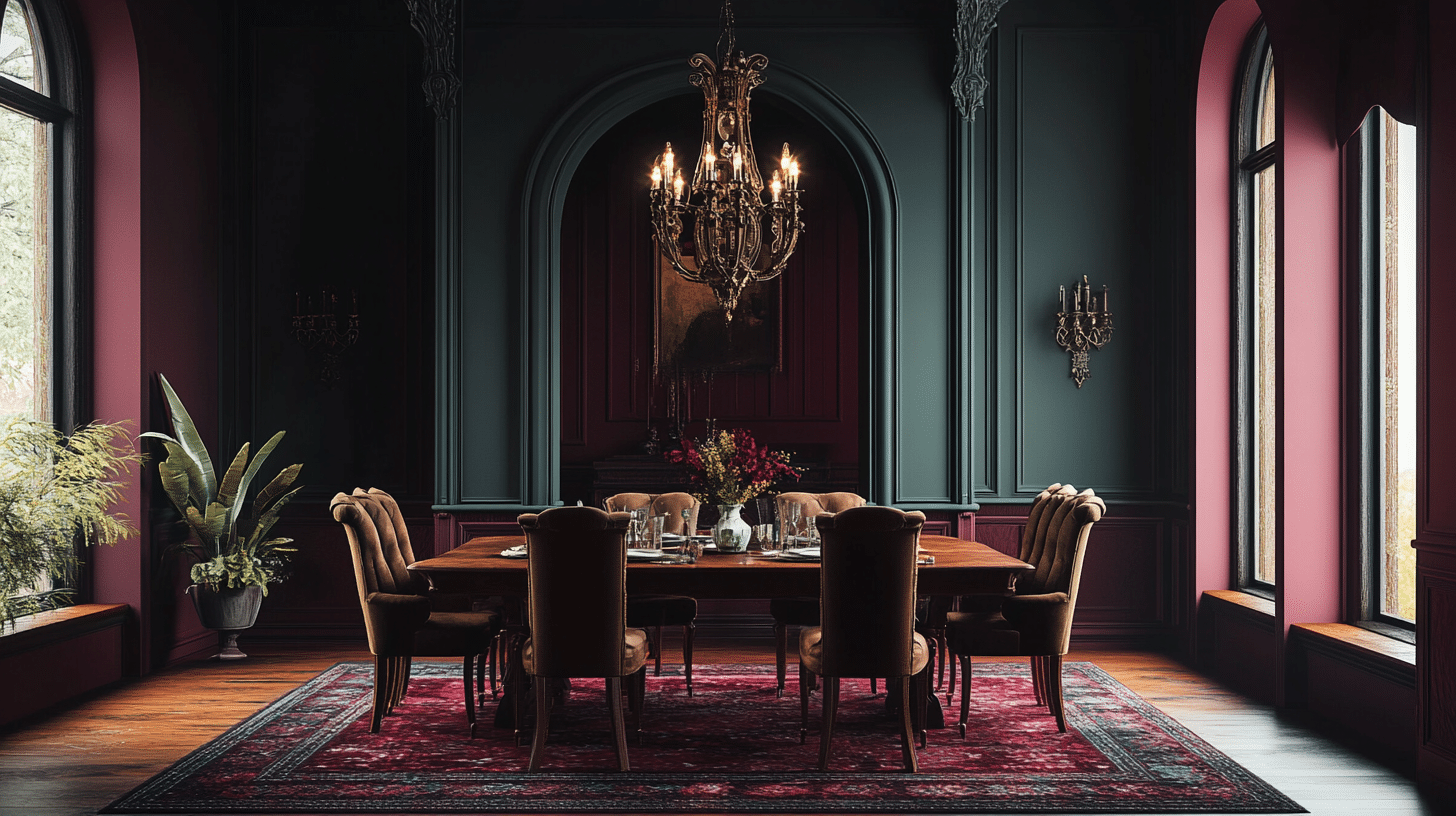
Moody Dining Atmosphere
Create a Gothic dining room with rich wall colors that set a dramatic tone.
Burgundy adds warmth, navy blue creates depth, and forest green offers a natural yet sophisticated background. For impact, paint all walls or just one accent wall.
Position your dining table centrally under a statement chandelier hanging 30-36 inches above the surface.
Choose a substantial table with good proportions and carved details. For a formal, balanced arrangement, select matching upholstered chairs with high backs featuring Gothic details like pointed arches.
Decorative Accents
Incorporate carved wood elements throughout the room—in furniture, crown molding, or decorative screens. These historical details add authentic Gothic character through pointed arches, rosettes, or nature-inspired patterns.
Add a glass-fronted display cabinet to showcase fine dishware and crystal. Choose one with Gothic architectural details to make it a focal point even when closed.
Introduce metallic accents with silver candlesticks, gold-rimmed plates, or brass serving pieces.
A large mirror with a gilded frame reflects light, while metal wall sconces provide atmospheric lighting that complements the Gothic theme.
Combining Original Gothic Architecture with Modern Design
Original Features
When working with authentic Gothic architecture, preservation becomes your guiding principle.
Original vaulted ceilings, with their dramatic height and structural ribbing, create an unmatched impact—clean and highlight these features rather than hiding them.
Exposed stone walls, with their texture, tell a historical story; consider leaving sections visible while carefully insulating other areas for comfort.
Intricate woodwork in panels, beams, and trim deserves special attention. Gently clean these elements, repair them when necessary, and apply appropriate finishes to protect them without hiding their character.
Original stained glass casts colored light that no modern fixture can replicate—maintain these windows while possibly adding discreet secondary glazing for thermal efficiency.
These historic features gain new life when paired with contemporary furnishings. The key is balance—using simple modern pieces that complement rather than compete with ornate historical features.
Modern Updates for Comfort
Living comfortably in Gothic spaces requires the thoughtful integration of contemporary systems.
Update electrical wiring to support modern needs, but route it carefully to minimize impact on original features.
Install discreet lighting that highlights architectural elements while providing sufficient brightness for everyday activities.
Climate control presents challenges in historic buildings. Consider hydronic heating systems with minimal visual impact or slim-profile radiators designed for landmark spaces.
Contemporary furniture can improve comfort without sacrificing style. Look for pieces with clean silhouettes but luxurious materials that complement Gothic richness.
Technology can be integrated through hidden speakers, motorized window treatments, and concealed televisions.
Energy efficiency improvements protect both your comfort and the building itself—add insulation where possible without damaging historic features, upgrade window treatments, and install smart home systems to manage energy use efficiently.
Natural Textures in Gothic Interior Design
Floral Patterns
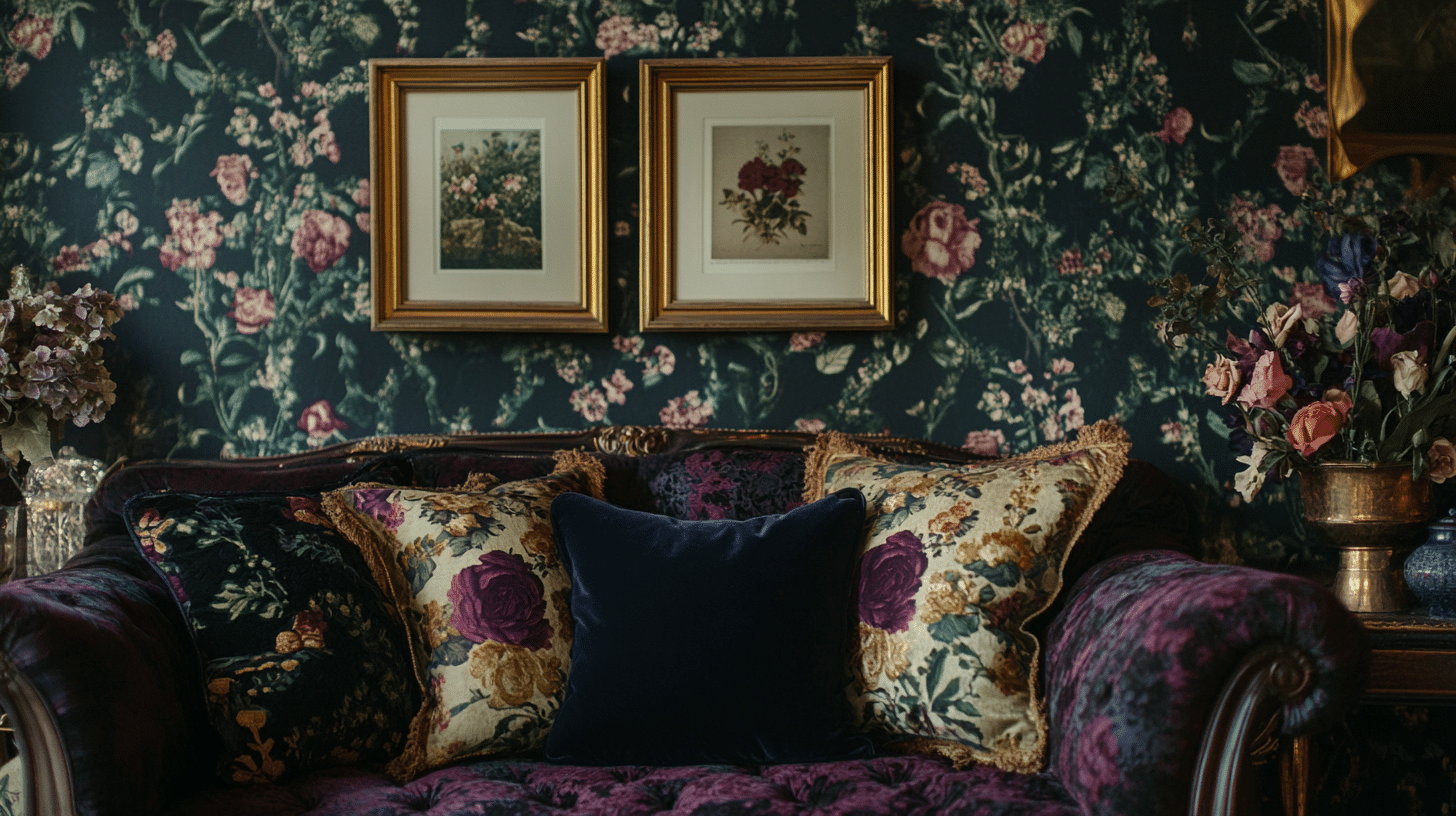
Gothic design isn’t all darkness and drama—natural elements provide essential balance and softness.
Floral patterns connect Gothic interiors to the natural world, much as medieval cathedral stonework featured botanical motifs.
Intricate floral wallpaper in rich, moody colors adds depth to the walls. Deep burgundy backgrounds with navy flowers or forest green with subtle golden botanical patterns work particularly well.
For a smaller commitment, introduce floral throw pillows with detailed embroidery—look for those featuring roses, thistles, or oak leaves, all common in medieval design.
Botanical prints in simple gold frames create focal points that add scientific and natural interest to Gothic spaces.
Group these prints symmetrically for formal areas or in casual clusters in more relaxed rooms.
Fresh flowers in dark pottery or metallic containers bring life and scent to Gothic interiors, connecting these historically-inspired spaces to the changing seasons.
Natural Textiles
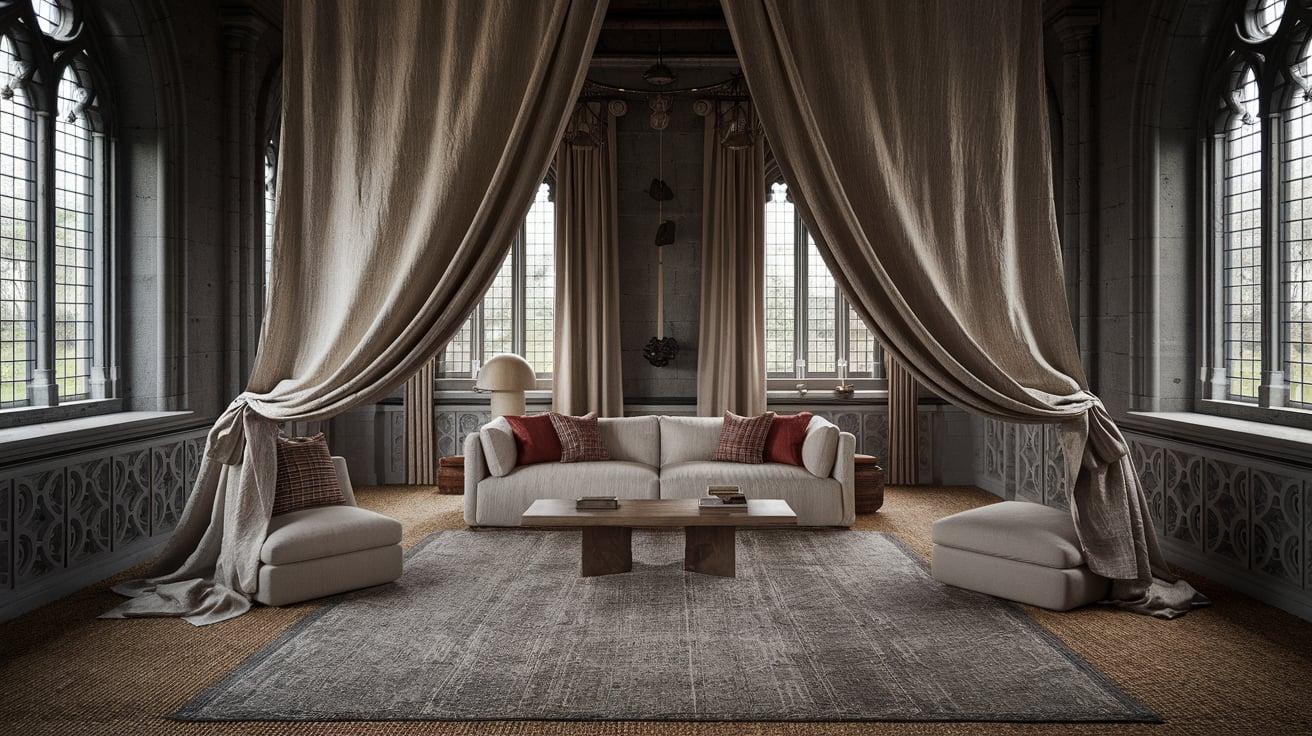
Natural fabrics add warmth and authenticity to Gothic design while improving comfort. Linen curtains that pool slightly on the floor create graceful lines and beautifully filter light.
Choose heavier weights for winter months and lighter options for summer. Wool rugs with traditional patterns anchor furniture groupings while adding insulation and sound absorption.
Look for deep colors with subtle patterns rather than bright, bold designs.
Cotton upholstery on seating offers practicality and comfort—select tightly woven fabrics in solid colors or small patterns for everyday use.
For special touches, incorporate raw silk on accent pillows or occasional chairs; this fabric catches light differently from every angle, adding movement to static spaces.
In casual areas, consider seagrass or jute floor coverings to contrast with more formal elements, bringing textural variety and natural warmth.
Layer different natural textiles throughout your space, mixing weights and finishes while maintaining a cohesive color scheme to create a Gothic interior that feels authentic yet comfortable.
Wood Accents
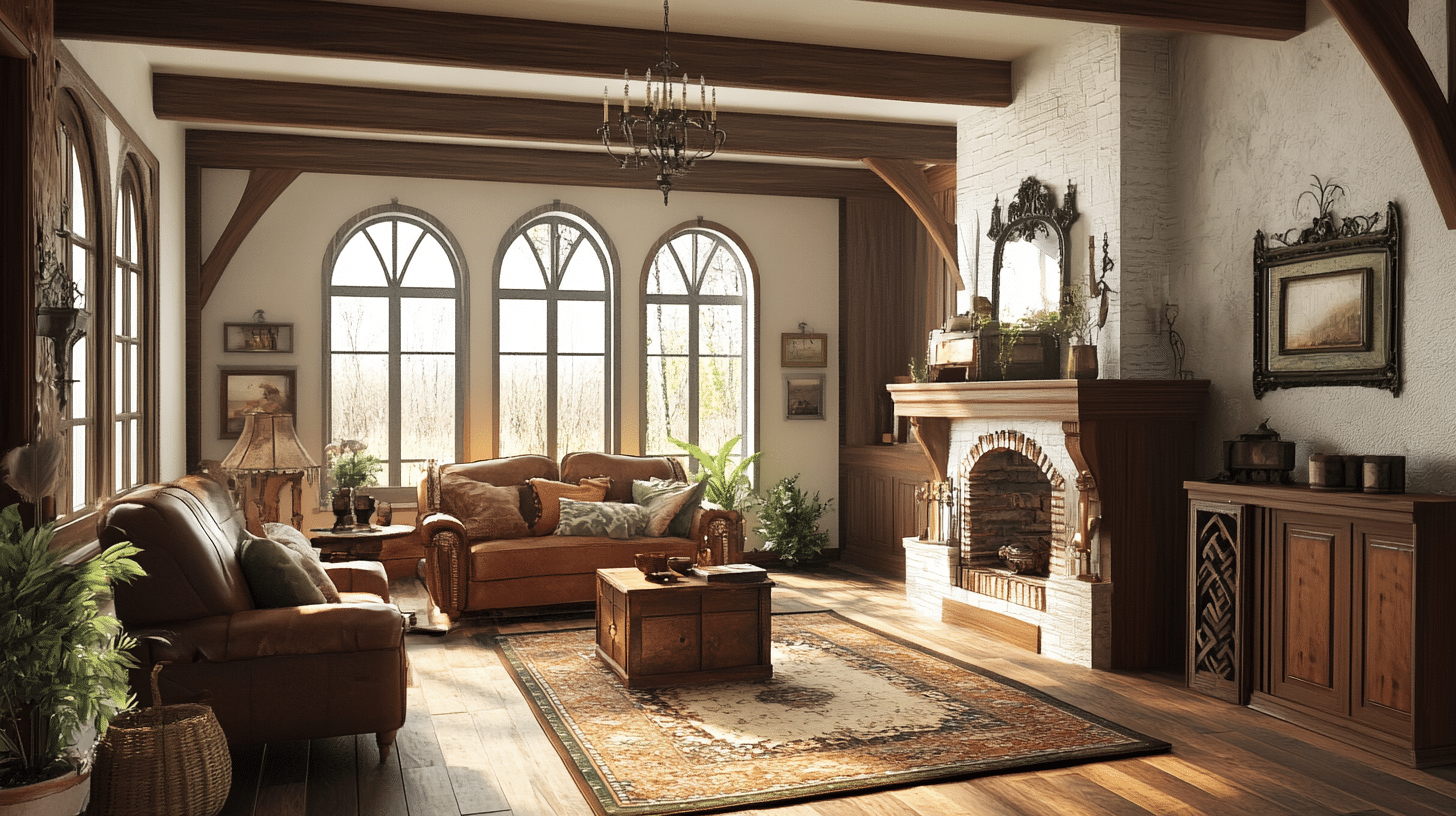
Wood elements ground Gothic interiors in tradition while bringing natural warmth.
Wide-plank hardwood floors in medium to dark tones provide the perfect foundation—oak, walnut, or reclaimed woods with visible grain and character match Gothic sensibilities.
If original floors aren’t possible, engineered wood or quality laminate with convincing texture can work well.
Exposed ceiling beams, whether structural or decorative, add architectural interest and historical accuracy. In spaces with standard ceilings, consider adding false beams in key areas to create the same effect.
Carved wooden details on mantels, doors, and furniture bring an authentic Gothic character to any room. Look for pointed arch motifs, quatrefoils, or nature-inspired carvings.
Balance different wood tones rather than matching everything precisely—mix darker statement pieces with medium-toned accents and lighter wood details.
This variety creates a collected-over-time feeling that feels more authentic than perfectly matched sets.
Wooden accessories like carved boxes, picture frames, and candlesticks add final touches of natural texture throughout your Gothic-inspired space.
Tips for Decorating with Gothic Interior Design
Create Balance with Dark and Light
- While Gothic design features rich, dark colors, successful Gothic interiors need light touches to prevent heaviness.
- Create contrast by pairing burgundy walls with cream trim, adding light silk pillows to a navy sofa, or using white marble on a fireplace against a dark green wall.
- Consider using dark colors on just one wall or in smaller rooms, while keeping connecting spaces in lighter neutral tones.
- Mirrors and reflective surfaces help bounce light throughout the room, making dark spaces feel more open and inviting.
Use of Chandaliers and Luxurious Lighting
- Lighting defines the mood in Gothic spaces. A wrought iron chandelier creates an instant Gothic focal point in dining rooms or entryways.
- Crystal chandeliers with candle-style bulbs offer historical accuracy with added sparkle. Wall sconces at eye level provide both practical task lighting and atmospheric glow.
- Look for fixtures with Gothic motifs like pointed arches. Add luxury through metallic finishes—brass fixtures create warmth, while silver brings cool brilliance.
- Crystal elements catch and reflect light, adding movement to Gothic rooms.
Wrapping Up
Gothic design continues to appeal because it combines drama, history, and comfort in ways few other styles can match.
Focusing on key elements—deep color palettes, pointed arches, carved details, and layered textures—can create spaces with genuine character and lasting impact.
The most successful Gothic interiors balance darkness with light, historical elements with modern function, and dramatic statements with practical comfort.
This thoughtful approach ensures your Gothic-inspired home remains both visually striking and thoroughly livable—a place where history and present day meet in perfect harmony.
If you want to know about other decor styles, go through our website.

